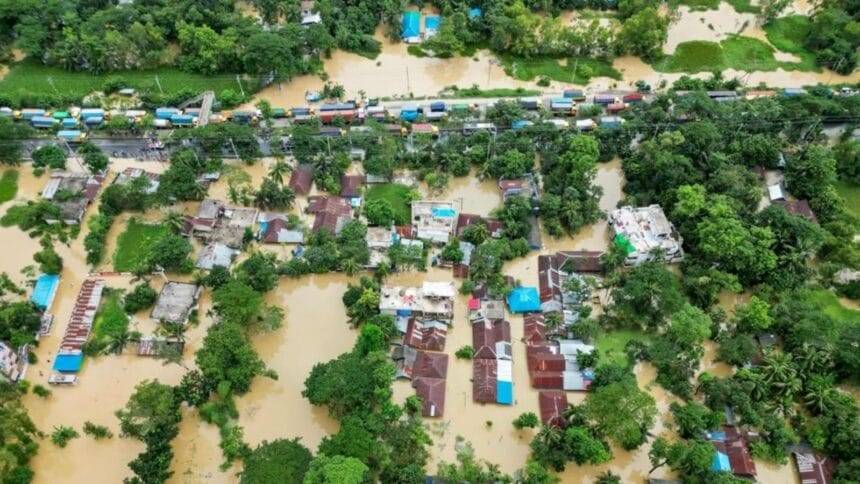Main Points In Hindi (मुख्य बातें – हिंदी में)
यहाँ बाढ़ की तैयारी को मजबूत करने के लिए कुछ महत्वपूर्ण बिंदुएं दी गई हैं:
-
जलवायु परिवर्तन और बाढ़ का बढ़ता खतरा: जलवायु संकट के परिणामस्वरूप इसके प्रभाव में वृद्धि, जैसे समुद्र स्तर में वृद्धि और अप्रत्याशित मौसम पैटर्न, बाढ़ की तीव्रता और आवृत्ति को बढ़ाते हैं।
-
बाढ़ पूर्वानुमान प्रणालियों का महत्व: तकनीकी प्रगति, जैसे उपग्रह इमेजरी, रडार डेटा, और वास्तविक समय निगरानी, बाढ़ भविष्यवाणी को सटीक बनाने में सहायक होती हैं। उदाहरण के लिए, अमेरिका का बाढ़ चेतावनी प्रणाली इन तकनीकों का उपयोग करके बाढ़ के जोखिमों को कम करने में प्रभावी है।
-
बुनियादी ढांचे और नीति के उपाय: बाढ़ को नियंत्रित करने के लिए तटबंध, जलाशय, और बाढ़-लचीले निर्माण की आवश्यकता होती है। इसके साथ ही, आपातकालीन तैयारी योजनाओं और सार्वजनिक जागरूकता अभियानों को बढ़ावा देना जरूरी है।
-
सहयोगात्मक अनुसंधान और वैश्विक सहयोग: बाढ़ जोखिम प्रबंधन के लिए अंतर्राष्ट्रीय सहयोग और विभिन्न देशों के बीच सूचना साझा करने की आवश्यकता है। नीदरलैंड, टोक्यो, और ऑस्ट्रेलिया के कुछ सफल 사례 इस दिशा में दिशा-निर्देश प्रदान कर सकते हैं।
- पर्यावरणीय उपाय और हरी बुनियादी ढांचे की आवश्यकता: आर्द्रभूमि की पुनर्स्थापना, मिट्टी संरक्षण और स्मार्ट बाढ़ सेंसर, जैसे पर्यावरणीय उपाय बाढ़ के जोखिम को कम करने में सहायक हो सकते हैं।
Main Points In English(मुख्य बातें – अंग्रेज़ी में)
Here are the main points from the article regarding measures to strengthen flood preparedness:


-
Impact of Climate Change on Floods: The article highlights the significant increase in flooding events across multiple continents, particularly due to climate change. Rising sea levels and unpredictable weather patterns are intensifying the frequency and severity of flooding, exemplified by recent floods in countries like India, Bangladesh, and China, resulting in loss of life, displacement, and economic damage.
-
Health and Economic Risks: Flooding not only leads to immediate loss of life and property but also increases long-term health risks, such as waterborne diseases, food shortages, and environmental degradation. Communities face challenges in recovery that impact education, healthcare, and mental health.
-
Advancements in Flood Prediction: Technological advancements in meteorology and hydrology enable better flood prediction through satellite imagery, radar data, and real-time monitoring systems. Utilizing statistical and physical modeling can help identify patterns and simulate flood behavior, leading to more accurate forecasts.
-
Successful Flood Forecasting Systems: The article outlines successful flood prediction systems from around the world, including those in the U.S., Europe, India, and Bangladesh. The U.S. flood warning system is highlighted as a model due to its integration of real-time data, automated alerts, and advanced hydrological forecasts, helping mitigate risks effectively.
- Necessary Infrastructure and Policy Measures: Effective flood management requires a combination of infrastructure development (such as levees and flood control channels) and policy measures (like building codes and emergency response plans). Environmental strategies, including wetland restoration and watershed management, along with international cooperation for flood risk assessment and management, are essential to reduce future flood risks.
Complete News In Hindi(पूरी खबर – हिंदी में)
इस वर्ष अकेले सितंबर में चार महाद्वीपों में बाढ़ आई, जिसके परिणामस्वरूप हजारों लोगों की हानि हुई और अभूतपूर्व क्षति हुई। एशिया के भीतर, भारत में (असम, अरुणाचल प्रदेश, मेघालय, सिक्किम, मणिपुर, त्रिपुरा, उत्तर प्रदेश, हिमाचल प्रदेश, गुजरात और केरल में) बाढ़ आई, जिसके परिणामस्वरूप 719 मौतें हुईं और 350,000 से अधिक लोग विस्थापित हुए। जून में, बांग्लादेश में बाढ़ से हजारों लोग प्रभावित हुए, पाकिस्तान में भारी बारिश के कारण बाढ़ आई, चीन में, अधिकारियों को गुआंग्डोंग में 110,000 लोगों को उनके घरों से निकालना पड़ा, क्योंकि भारी बारिश के कारण चीन के सबसे अधिक आबादी वाले प्रांत में भारी बाढ़ आई। इंडोनेशिया में सुमात्रा और पश्चिमी सुमात्रा में अचानक बाढ़ आ गई, जबकि नोटो भूकंप के कारण जापान में बाढ़ आ गई। श्रीलंका में भारी बारिश के कारण बाढ़ भी आई। दुनिया भर में बाढ़ की घटनाओं में एक सामान्य कारक है – जलवायु संकट के कारण वातावरण का गर्म होना। जलवायु संकट का बाढ़ की तीव्रता और आवृत्ति पर गहरा प्रभाव पड़ता है, समुद्र के बढ़ते स्तर और अप्रत्याशित मौसम पैटर्न के कारण दुनिया भर में बाढ़ की तीव्रता बढ़ जाती है।
बाढ़ से न केवल जानमाल का नुकसान होता है, बल्कि गंभीर विस्थापन के साथ-साथ बुनियादी ढांचे और अर्थव्यवस्था को भी व्यापक नुकसान होता है। यह जल-जनित बीमारियों, भोजन की कमी और पर्यावरणीय गिरावट के कारण स्वास्थ्य जोखिमों को भी बढ़ाता है। समूहों और समुदायों को भी अक्सर शिक्षा, स्वास्थ्य देखभाल और मानसिक स्वास्थ्य पर प्रभाव के साथ दीर्घकालिक पुनर्प्राप्ति चुनौतियों का सामना करना पड़ता है। भले ही पूरी तरह से सटीक न हो, बाढ़ की भविष्यवाणी सटीकता की अलग-अलग डिग्री के साथ की जा सकती है। प्रौद्योगिकी, मौसम विज्ञान और जल विज्ञान में प्रगति वैज्ञानिकों को उपग्रह इमेजरी, रडार और वर्षा गेज डेटा, जल विज्ञान मॉडल, मौसम पूर्वानुमान मॉडल और वास्तविक समय निगरानी प्रणालियों का उपयोग करके बाढ़ का पूर्वानुमान लगाने में सक्षम बनाती है। सांख्यिकीय मॉडलिंग में, वैज्ञानिक पैटर्न की पहचान करने के लिए ऐतिहासिक डेटा का विश्लेषण करते हैं, जबकि भौतिक मॉडलिंग में, हाइड्रोलॉजिकल और हाइड्रोलिक मॉडल का उपयोग करके बाढ़ व्यवहार पर सिमुलेशन बनाए जाते हैं। एन्सेम्बल पूर्वानुमान बेहतर सटीकता के लिए कई मॉडलों को जोड़ता है। हालाँकि, दुनिया भर के देशों को बेहतर प्रारंभिक चेतावनी प्रणाली, भौगोलिक सूचना प्रणाली, रिमोट सेंसिंग, आर्टिफिशियल इंटेलिजेंस और मशीन लर्निंग और इंटरनेट ऑफ थिंग्स (IoT) सेंसर की आवश्यकता है।
सफल बाढ़ पूर्वानुमान प्रणालियों के कुछ उदाहरणों में संयुक्त राज्य अमेरिका (यूएस) की राष्ट्रीय बाढ़ पूर्वानुमान प्रणाली, यूरोपीय बाढ़ जागरूकता प्रणाली, भारत की बाढ़ पूर्वानुमान और चेतावनी प्रणाली और बांग्लादेश बाढ़ पूर्वानुमान और चेतावनी प्रणाली शामिल हैं। हालाँकि, इन चारों ने अलग-अलग स्तर की बाढ़ का अनुभव किया है, जिसके परिणामस्वरूप विभिन्न स्तर का नुकसान हुआ है, जो प्रौद्योगिकी में और निवेश की आवश्यकता का उदाहरण है। फिर भी, अमेरिकी बाढ़ चेतावनी प्रणाली अन्य देशों के लिए एक मॉडल के रूप में कार्य करती है, जो बाढ़ के जोखिमों को कम करने में एकीकृत वास्तविक समय डेटा, स्वचालित अलर्ट और उन्नत जलवैज्ञानिक पूर्वानुमान के महत्व को प्रदर्शित करती है। जबकि इस वर्ष दक्षिण कैरोलिना में बाढ़ की सूचना मिली थी, नुकसान अभी भी अपेक्षाकृत कम है और लगभग 122 मिलियन लोगों को अपने समुदायों में बाढ़ का खतरा है। अमेरिका में बाढ़ चेतावनी प्रणाली वास्तविक समय डेटा, वर्षा अनुमान और चेतावनी प्रोटोकॉल पर बनाई गई है, जो सभी एक ही सॉफ्टवेयर प्लेटफॉर्म में एकीकृत है। प्लेटफ़ॉर्म विभिन्न हार्डवेयर के साथ काम करता है और निर्णायक कार्रवाई करने के लिए विश्वसनीय डेटा प्रदान करता है।
अमेरिकी बाढ़ चेतावनी प्रणाली की प्रमुख विशेषताओं में वास्तविक समय की निगरानी शामिल है, जिसमें सिस्टम विभिन्न स्थानों में वर्षा और बाढ़ के जोखिमों को ट्रैक करने के लिए सेंसर और गेज का उपयोग करता है। जब एक सीमा पूरी हो जाती है, तो आपातकालीन कार्य योजना शुरू करने के लिए एक स्वचालित अलर्ट भेजा जाता है। यह प्रणाली विभिन्न परिदृश्यों में बाढ़ की सीमा का अनुमान लगाने के लिए तूफान मॉडलिंग और सिमुलेशन का भी उपयोग करती है। हाइड्रोलॉजिकल पूर्वानुमान पर भी भरोसा किया जाता है, क्योंकि यह बाढ़ का मानचित्रण प्रदान करता है, जिससे उन्नत लीड टाइम यह संकेत देने में सक्षम होता है कि कौन से क्षेत्र प्रभावित हो सकते हैं।
इस प्रकार, जैसा कि अमेरिकी बाढ़ के उदाहरण से देखा गया है, बुनियादी ढांचे, नीति और पर्यावरणीय उपायों के संयोजन के माध्यम से कम किया जा सकता है। बुनियादी ढांचे के निर्माण के संदर्भ में, तटबंध और बाढ़ की दीवारें, बांध और जलाशय, बाढ़-नियंत्रण नहरें और चैनल, तूफान प्रबंधन प्रणाली और समुद्री दीवारें और तटीय सुरक्षा एक तत्काल आवश्यकता है। नीति और नियोजन उपायों के दायरे में, बिल्डिंग कोड और बाढ़-लचीले निर्माण के साथ-साथ बाढ़ मैदान प्रबंधन और ज़ोनिंग विनियमन की आवश्यकता है। आपातकालीन तैयारी और प्रतिक्रिया योजनाएँ भी एक तत्काल प्राथमिकता हैं, इसके बाद बाढ़ बीमा कार्यक्रम और सार्वजनिक शिक्षा और जागरूकता अभियान हैं। पर्यावरणीय उपायों में आर्द्रभूमि पुनर्स्थापन और संरक्षण, वाटरशेड प्रबंधन और पुनर्वनीकरण, मिट्टी संरक्षण और कटाव नियंत्रण, बाढ़ के मैदान का पुनर्निर्माण और प्राकृतिक बाढ़ प्रबंधन के साथ-साथ जलवायु संकट शमन और अनुकूलन रणनीतियाँ शामिल हैं। बाढ़ के शमन में परिणाम दिखाने के लिए, हरी छतों और वर्षा उद्यानों, स्मार्ट बाढ़ सेंसर और निगरानी प्रणालियों और समुदाय-आधारित बाढ़ जोखिम प्रबंधन सहित हरित बुनियादी ढांचे की भी आवश्यकता होगी।
सहयोगात्मक अनुसंधान और विकास और वैश्विक बाढ़ जोखिम मूल्यांकन और मानचित्रण के साथ-साथ सीमा पार बाढ़ जोखिम प्रबंधन, अंतर्राष्ट्रीय बाढ़ पूर्वानुमान और चेतावनी प्रणाली के क्षेत्र में अंतर्राष्ट्रीय सहयोग की भी तत्काल आवश्यकता है। कुछ केस अध्ययनों में नीदरलैंड का रूम फॉर रिवर प्रोजेक्ट शामिल है जो बाढ़ के मैदान की बहाली पर केंद्रित है, टोक्यो की बाढ़ सुरक्षा प्रणाली, जो भूमिगत सुरंगों और नहरों के निर्माण पर केंद्रित है, और ऑस्ट्रेलिया की राष्ट्रीय बाढ़ जोखिम सूचना परियोजना जो डेटा-संचालित निर्णय लेने पर केंद्रित है। इन उपायों के कार्यान्वयन के लिए बाढ़ को प्रभावी ढंग से रोकने और कम करने के लिए सरकारों, समुदायों और हितधारकों के समन्वित प्रयास की आवश्यकता होगी।
यह लेख श्रीपर्णा पाठक, एसोसिएट प्रोफेसर, चीनी अध्ययन और अंतर्राष्ट्रीय संबंध, जिंदल स्कूल ऑफ इंटरनेशनल अफेयर्स, ओपी जिंदल ग्लोबल यूनिवर्सिटी, सोनीपत द्वारा लिखा गया है।
Complete News In English(पूरी खबर – अंग्रेज़ी में)
This September alone, floods impacted four continents, leading to thousands of deaths and unprecedented damage. In Asia, India experienced significant flooding in states such as Assam, Arunachal Pradesh, Meghalaya, and others, resulting in 719 deaths and displacing over 350,000 people. In June, heavy rains in Bangladesh affected thousands, while Pakistan also faced flooding. In China, heavy rainfall forced authorities to evacuate 110,000 people in Guangdong province due to severe flooding. Indonesia saw sudden floods in Sumatra, and Japan experienced flooding due to an earthquake. Additionally, Sri Lanka faced heavy rainfall and subsequent flooding. A common factor in these global flooding events is climate change, which is causing warmer weather. The climate crisis deepens the intensity and frequency of floods, as rising sea levels and unpredictable weather patterns contribute to more severe flooding worldwide.
Floods not only result in loss of life but also cause significant displacement and damage to infrastructure and the economy. They increase health risks due to waterborne diseases, food shortages, and environmental degradation. Communities often face long-term recovery challenges that can affect education, healthcare, and mental health. While predicting floods is not completely accurate, technology advancements in meteorology and hydrology allow scientists to use satellite imagery, radar, and rainfall data for flood forecasting. Statistical modeling analyzes historical data for patterns, while physical modeling uses hydrological and hydraulic models to simulate flood behavior. Ensemble forecasting combines multiple models for better accuracy. However, countries worldwide need improved early warning systems, geographic information systems, remote sensing, artificial intelligence and machine learning, as well as Internet of Things (IoT) sensors.
Examples of successful flood forecasting systems include the U.S. National Flood Prediction System, the European Flood Awareness System, India’s flood forecasting system, and Bangladesh’s flood warning system. Despite their different levels of flood experiences and damages, these examples show the need for further investment in technology. The American flood warning system serves as a model for other countries by demonstrating the importance of integrated real-time data, automated alerts, and advanced hydrological forecasting in reducing flood risks. While there have been reports of flooding in South Carolina this year, losses have been relatively low, with around 122 million people facing potential flood risks in the U.S. The American flood warning system is built on real-time data, rainfall estimates, and warning protocols integrated into a single software platform that works with various hardware to provide reliable data for decisive action.
The key features of the U.S. flood warning system include real-time monitoring, using sensors and gauges to track rainfall and flood risks in different locations. When a threshold is reached, an automatic alert is sent to initiate an emergency response plan. The system also uses storm modeling and simulations to estimate flood extent under various scenarios. Hydrological forecasts are relied upon for flood mapping, enabling advanced lead times to indicate which areas may be affected.
As seen in the examples from the U.S., flood risks can be mitigated through a combination of infrastructure, policy, and environmental measures. In terms of infrastructure, the construction of levees, flood walls, dams, reservoirs, flood control channels, stormwater management systems, and coastal protections is an urgent need. Policy and planning measures require building codes for flood-resilient structures, floodplain management, and zoning regulations. Emergency preparedness and response plans are critical priorities, followed by flood insurance programs and public education and awareness campaigns. Environmental measures include wetland restoration and conservation, watershed management, reforestation, soil conservation, floodplain reconstruction, and natural flood management, along with climate crisis mitigation and adaptation strategies. To achieve effective flood mitigation, green infrastructure such as green roofs, rain gardens, smart flood sensors, and community-based flood risk management will also be necessary.
There is an urgent need for collaborative research and development, global flood risk assessment and mapping, and international cooperation in cross-border flood risk management, as well as international flood prediction and warning systems. Case studies such as the Netherlands’ Room for the River project, which focuses on floodplain restoration, Tokyo’s flood protection system, which includes underground tunnels and canals, and Australia’s National Flood Risk Information project, focused on data-driven decision-making, underscore this need. Implementing these measures will require coordinated efforts from governments, communities, and stakeholders to effectively prevent and reduce floods.
This article is written by Sriparna Pathak, Associate Professor of Chinese Studies and International Relations at the Jindal School of International Affairs, O.P. Jindal Global University, Sonipat.










